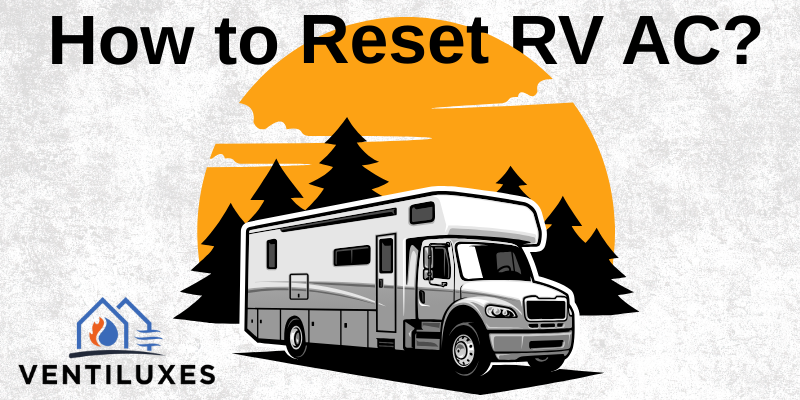If you’re scratching your head and unable to find the root cause of your RV AC not performing, even if you checked the thermostat and everything seemed fine, don’t worry. Your RV AC needs a reset to get back on track again. If this is your first time doing this task, it’s easy to do it within a few minutes without any technical background.
5 Steps to Reset an RV Air Conditioner
Follow the below steps:
Step # 1: Find the Circuit Breaker or Fuse Box
First, before starting the reset process, you have to find the location of the circuit breaker or fuse box. Doing this will avoid issues later on.
Typically, this box is inside the RV, hidden behind a panel, or in a closet. You have to open it to access the switches that control the whole power supply to your AC unit.
Step # 2: Switch Off the Air Conditioner Unit
Once you locate the circuit breaker, switch it off. There may be a bunch of other breakers, but you only have to turn off the one labeled for the air conditioner. Don’t rush and start the next steps; instead, wait a few moments after turning it off.
Step # 3: Press the Reset Button
For some models, you might find a reset button labeled “Reset” or “Restart” on the exterior control panel of the unit. Since this button is tiny, you need a needle or even an ejector pin to press it. Now press and hold this button for at least 5-7 seconds before releasing the pressure from it.
Step # 4: Observe the Air Conditioner’s Response
Once you release the reset button, after some moments, check the indicator lights to flash or listen for a beep sound. It signifies that the unit is getting back to routine. Also, it means the AC is trying to restart and will start cooling again.
Step # 5: You Done the “RV AC Reset”
That’s it. Once the air conditioner has attempted to restart, let it run for a few minutes. You can change its speed or temperature to double-check the cooling. If it’s working correctly, congratulations—the reset was successful.
What if the Issue is Still There?
Hopefully, the above process will resolve most of the issues; unfortunately, if you still face the performance issue, it means that there’s more extensive troubleshooting required to identify the roots of inefficiency,
How Do You Know That Your RV AC Needs a Reset?
Identifying when your RV air conditioner needs a reset can save you from discomfort and potential repair costs down the line.
Here are some clear indicators:
- Inconsistent Cooling: If the air conditioner is not cooling as evenly as it is used.
- Unusual Noises: Just like normal HVAC noises from the unit—such as rattling, buzzing, or whistling. These may also come from the RV ACs. While it indicates that a reset is necessary to clear potential errors.
- Error Messages: Modern RV air conditioners often have digital displays that show error codes when there’s a problem. So, you can read your owner’s manual as a reference to understand these codes can confirm the issue.
- High Energy Consumption: If your RV’s energy consumption spikes without an increase in AC usage, the AC setting is wrong. Thus, it might work harder than needed due to a system error that a reset could fix.
- Short Cycling: If the AC turns on and off more frequently than usual without adequately cooling the RV. It often indicates a communication error that a reset may correct within the unit.
- After a Battery Change: It’s a good practice to reset the AC after you change the giant RV batteries. The power fluctuations can disrupt the system settings or cause the unit to malfunction.
5 Benefits of Resetting Recreational Vehicle AC
- Improved Energy: After a reset, your AC might operate more efficiently. Why? As it’s now clear of any glitches or errors in the system.
- Offer Better Air Quality: Resets help the air filters and internal mechanisms work at their peak and filter out pollutants and allergens from the air.
- Decreased Humidity Levels: An often-overlooked benefit is its potential to better manage and reduce humidity levels inside the space.
- Prevention of Freezing Up: If the AC occasionally freezes. You can prevent this problem by recalibrating the cooling cycle and temperature controls.
- Quieter Operation: Resets also eliminate unknown faults that might cause the AC unit to produce more noise. You’ll enjoy your trips and notice that the unit runs quieter and contributes to a more peaceful environment.
8 Tips for Maintaining Your RV Air Conditioner
These tips will prolong the unit’s life if you want to keep the RV air conditioner in tip-top condition. Here are some of those practical tips:
- Regular Filter Changes: Change or clean the air filters at least once a month during peak usage seasons.
- Seal and Insulate: Check and maintain the seals around your RV’s windows and doors to prevent cool air from escaping.
- Shade Your Unit: Whenever possible, park your RV in a shaded area or use a cover over the AC unit.
- Annual Inspections: Add a reminder in your calendar to schedule professional inspections at least once a year. A technician will check the refrigerant levels and quick-check all of the components.
- Adjust the Thermostat: Avoid setting the thermostat too low. Setting it to a comfortable 78 degrees during the day and slightly higher when not inside can reduce the workload.
- Use Fans to Circulate Air: You can install small oscillating fans to help circulate the cool air.
- Ventilate: When the outside temperature cools in the evening, turn off the AC and open windows to let the cool air in.
- Solar Reflective Coatings: You can apply a solar reflective coating to the roof to reflect the sunlight away.
Conclusion
All in all, just like you care for your home’s Air conditioner, you should also keep your RV AC in good condition. Always ensure your AC power setups are correct, and never hesitate to consult your manual or a professional if you’re unsure.


Leave a Reply